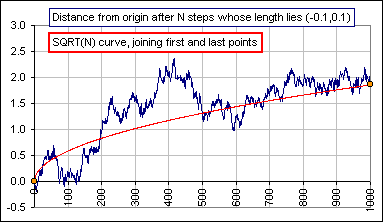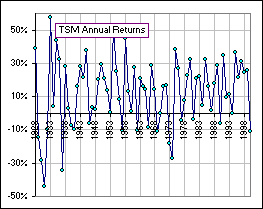| Standard Deviation ... and the Square Root of Time |
When calculating the Standard Deviation for annual returns, one often computes the Standard Deviation of monthly returns, then multiplies by the square-root-of-12.
>Why 12?
Because "annual" means 12 months and there are 12 months in a year.
>So if I want the Standard Deviation for 5-year returns I'd multiply
the monthly returns by 60, because there are 60 months in ...?
Wrong! Pay attention! You'd multiply the Standard Deviation of monthly returns by the
square root of 60 to get the Standard Deviation of 60-month Returns.
>I see. So, if I have the Standard Deviation of 1-month returns, then I multiply by
SQRT(N) to get the Standard Deviation for N-month returns, right?
Yes, and it works for years as well as months. Multiply the SD for 1-year Returns by SQRT(20) and
you'll get the SD of ...
>The SD of 20-year returns!
You got it.
>So, is this square root stuff for real? I mean, am I guaranteed to
get the Standard Deviation of N-month returns by multiplying the SD of
1-month Returns by SQRT(N)?
Well, let's do the following:
- We'll use the S&P 500 monthly returns, starting in 1950 ... and running for 60 months.
- We'll compute the Standard Deviation of these 60 1-month returns.
- Then we'll consider the 2-month returns, again starting in 1950 and calculate the SD for the 2-month returns.
- Then we'll consider the 3-month returns, again starting in 1950 and calculate the SD for the 3-month ....
>Okay, I get the idea. Then you plot the SD versus the number of months, right?
Right, and we compare to the plot of the (SD of 1-month returns) x (the square root of months).
We get this:

>Hey! That's pretty close, eh?
Yes. Now let's do it for the returns starting in ...
>Try 1930!
Okay, here's a couple:

>Hmmm ... not so good.
Nevertheless, this square-root stuff is often used to "annualize" a monthly Standard Deviation.
>By multiplying by the square root of 12.
Right.
>But in these charts you're just going ahead 24 months or two years. How about ...?
Okay, let's try it with years. We'll again start in 1950 with the S&P 500 and calculate the
Standard Deviation of 1-year returns, then 2-year returns, etc. etc. We get the following:

>It seems to work okay for a few years, then it's way off.
Yes, it would seem that way.
>So where does this square-root stuff come from?
It goes like so:
- We start at x = 0 and take a step, either right or left.
- The length of the step we take is somewhere between -0.1 and 0.1 and the average step length is zero.
- We ask: "After N such steps, how far are we from where we began?"

>So what does this have to do with investments returns and ...?
Okay, consider the U.S. Total Stock Market (TSM) from year 1928 to year 2000.
Here's what we'll do:
- We consider the Annual Returns over this period, like so:

The Mean and Standard Deviation are M = 12.4% and S = 20.2%, respectively.
>Wild!
Pay attention. We can smooth this out like so:
- Consider the 10-year intervals, from 1928 to 1938, then 1929 to 1939, etc. and
calculate the annualized return for each 10-year interval.
That is, we invest $1.00 and if it grows to $7.89 after 10 years,
then the "Annualized Return" is
7.891/10 - 1 = 0.229 or 22.9% and, in general, if our $1.00 grows to $N, the Annualized Return is N1/10 - 1.
- These Annualized Returns (over 10 years) look like so:

>So the volatility would be less, right?
Right. In fact, it's more like: (Annual Standard Deviation)/Square-root-of-10 = 20.2/SQRT(10) = 6.4%
>Aaah. The ubiquitous square root. That's exact, right?
No. It's an approximation, but compares well with the actual Standard Deviation of annualized returns (over 10 years).
- The comparison looks like so:

You can check out SD-stuff or
 for Part II: Risk/Reward ratios.
for Part II: Risk/Reward ratios.
